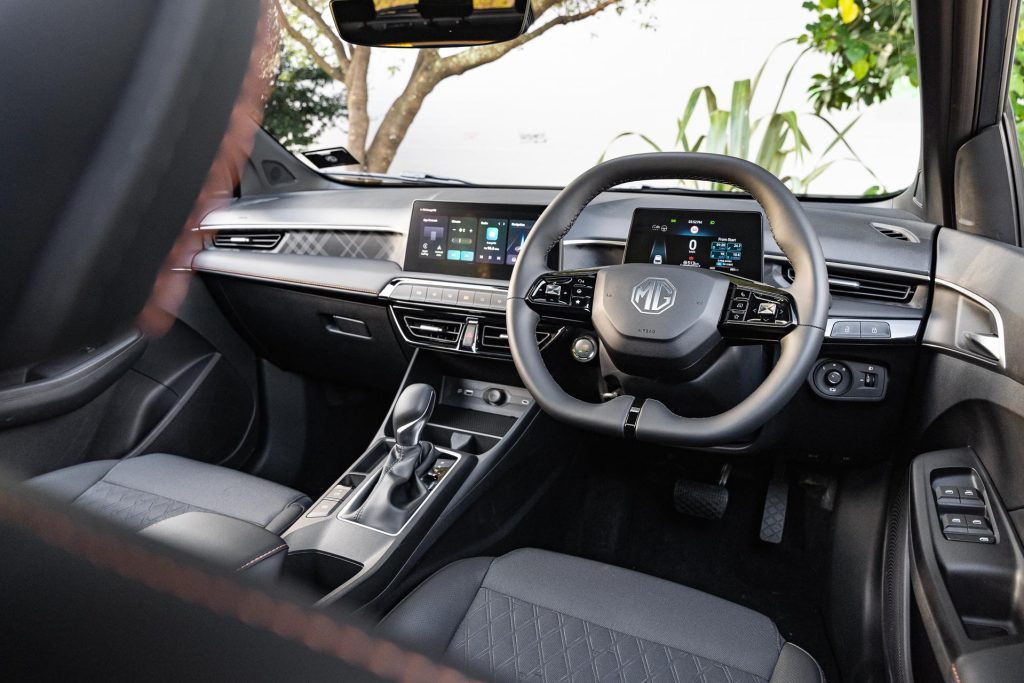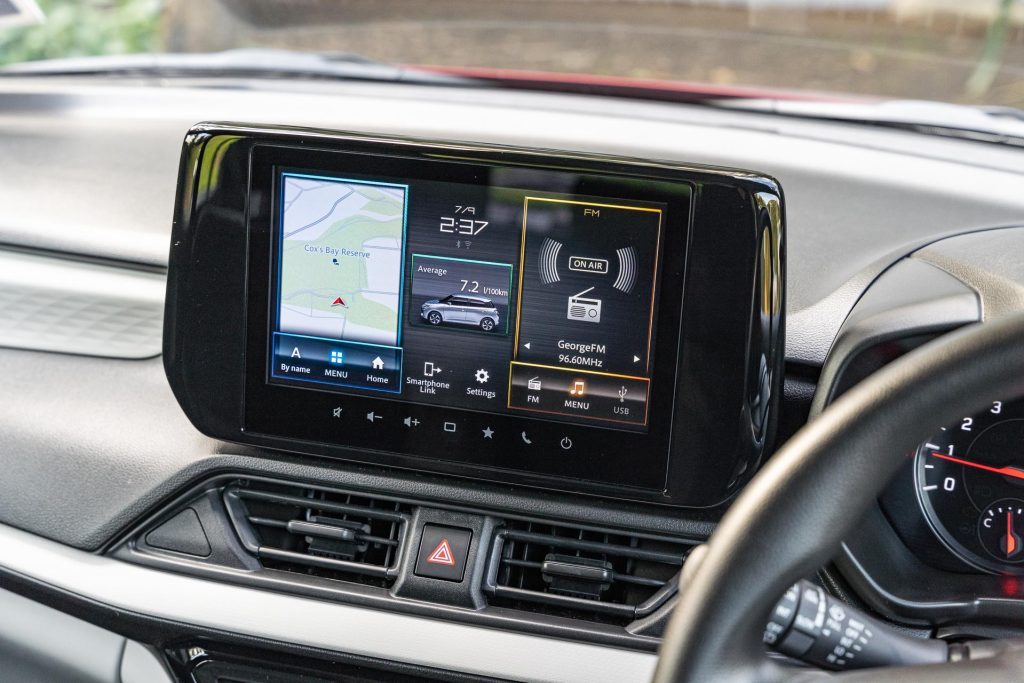2024 MG3 Essence vs Suzuki Swift GLS comparison review
Words: Peter Louisson | Photos: Isaac Western
Suzuki and MG recently renewed their small cars, both line-ups featuring hybrids. We compare two identically priced models, one a hybrid, one not.
MG3 used to be the least expensive car you could buy brand new in New Zealand until recently at roughly $20k.
Now that’s been superseded by an entirely new range, with petrol and hybrid powertrains, it is no longer the cheapest, the Excite Petrol kicking things off at $25,990. So the Suzuki Ignis takes over as the new car price leader ($21,990) in New Zealand.
Anyhow, the entry-level MG3, dubbed Excite, happens to cost exactly the same as the least expensive new-generation GLS Suzuki Swift, at least in manual form (Swift CVT adds $2k).

However, MG3 also comes in higher Essence spec, adding $2k to the bottom line. So the two cars you see here are identically priced.
However, Suzuki has gone mild hybrid across the board whereas the MG can also be had with ICE power alone (as here) or as a more sophisticated hybrid, with a separate generator and traction motor.
Hence, it is more expensive (kicks off at $30k). Despite its added complexity the hybrid uses no less fuel than the Suzuki, slightly more overall according to rightcar.
Therefore the Suzuki is looking like it is better buying, at least on paper. Would this turn out to be the case?
Nitty gritty on fuel use
Who’d not want the advantages of electrification over none, especially at a value price? The most obvious advantage of electrification is reduced fuel use.

The Suzuki employs a 1.2L naturally aspirated three-pot engine mated to an integrated starter generator (ISG), the former good for 61kW and 112Nm. The ISG contributes 2.3kW and 60Nm, helping out at restarts primarily (of the engine and of the car away from stopped).
MG3 petrol uses a 1.5-litre four-cylinder engine that makes 81kW and 142Nm. Where the fourth-gen Suzuki is said to use 4.3L/100km overall in its CVT guise (4.0 for manual), the petrol-only MG3 excite uses roughly 50 per cent more (6.0L/100km).
Rightcar suggests an even higher figure of 6.7L/100km. However, MG3 runs on 91, the Suzuki requires 95.
Helping the Suzuki on the fuel use front is a stop-start system that’s inaudible in operation. MG3 petrol doesn’t have this. The Suzuki is lighter too, by over 200kg (989 vs 1199kg).

And so if you’re primarily after a vehicle that uses precious little fuel, the Suzuki would be the one to covet. Its 4.3L/100km figure is doable and at times we saw figures in the high threes on the motorway, with a worst of 5.2L/100km.
You might have seen in the news that local hypermiler, Donn Anderson, managed 3.3L/100km during a 200km economy run in and around Auckland.
Matching him might be difficult but stick to 80km/h in the right places and you possibly could.
By contrast the bigger 1.5 four-pot engine in the MG3 which also runs a CVT used around 6.5L/100km at open road speeds in our hands and sevens in the burbs. It is doing roughly the same 2000rpm at 100km/h as the Suzuki.
As to performance, despite its lesser figures, Swift was quicker by a small amount than the MG3, no doubt a reflection of its lighter weight.

Swift has a wee button on the lever that acts like an old-school overdrive for a burst of speed. The Suzuki proved slightly noisier on chip seal.
Specification favours the MG
MG3 Essence is the same mechanically as Excite but adds goodies like a sunroof, leatherette upholstery, satellite navigation, a 360-degree camera, LED headlights, a leather wrapped wheel, and keyless entry, being the more important items.
New Zealand isn’t an ideal environment for a sunroof much of the time and your phone has sat nav. But then Essence is only $2k more, and we’d probably say yes on account of the LED headlights, the 360 degree camera, leatherette trim and keyless entry as much as anything.

The Suzuki spec for the same money? No sunroof here, 360-degree camera or leather wrapped wheel but LED headlights are standard. So is a four-way adjustable steering column.
It too gets ACC (with stop and go) and sat nav while each has traffic sign recognition, AEB, lane departure warning and centring, and high beam assist. The MG adds BSM and RCTA.
They both have keyless entry and pushbutton start, along with Bluetooth phone connectivity. The Swift’s seats are cloth trimmed.
The MG has a seven-year unlimited kay warranty, the Swift five years/100,000km (three years plus two-year powertrain extension).

How do they come across?
MG3 looks much bigger than before, and it measures up at 4.1m long, the five-door hatch offering 293L of boot space. By contrast, the Suzuki is 3860mm long and offers 265L of luggage capacity.
The new MG3 features various character lines along the flanks and a sloping bonnet that drops away pleasingly. It has an up-for-it facial expression too. Inside it bears almost no resemblance to the old model, and is vastly improved.


The Suzuki retains the overall shape of the former generation but features new lights all round, a clamshell bonnet and all door handles now run just below the waist line.
It’s a more modern and yet somehow familiar look, no doubt appealing both to the faithful and potential newcomers. Inside is fresher but without quite the flash of the MG.
And that’s most apparent with the new central infotainment system that pretty much runs the MG3. However, one aspect MG overlooked in the update was a four-way steering column.

That might not seem like a big deal but it does have significant repercussions for comfort. Because the wheel doesn’t extend out, taller people will find themselves sitting too close to the pedals.
With the seat set forward, that makes ingress and egress more difficult than in the Suzuki. Moreover, MG has opted for softer seat foam which initially feels cushy but you soon find yourself sitting too low in the seat which has precious little inbuilt lumbar support.
I quickly found myself squirming in this. The Suzuki has firmer seat foam, part of its ergonomic seat update. And with a four-way steering column and better lower back support, this is fine for longer driving stints.

The MG3 split-folding involves the entire back rest where the Suzuki you can split-fold 60/40.
Bing bong
Safety reminders separate this pair. They both have them, only one is more vocal while the other makes do with visual reminders.
The MG is more insistent but you can turn off the overspeed rebukes without actually turning off traffic sign recognition.

The bad news is you need to do it each time you restart the vehicle. Same same with the lane departure warnings. Fortunately it’s only a three-step process using the central touchscreen and some we’d expect will have no issue with the reminders in the first instance.
Might save you a ticket. I’d rather keep an eye on speed myself and leave the rebukes to my front seat passenger.
In the Suzuki, on the odd occasion when you need to delve into the new more vibrant touchscreen, it responds instantly.
That in the MG can be a bit hit and miss, until you realise that a quick solid tap is what it responds to best. Even then the response isn’t that quick. But you get used to it, and you have to because most items devolve to the centre screen.

In the Suzuki, the climate controls are separate and analogue like. And some items like auto stop/start are controlled by pushbuttons.
There’s also an info button on the wheel which you can use to scroll through myriad items, including instantaneous and average fuel readout, digital speed etc.
Further over by the door is the stop start button, easily visible and easily accessed. The MG’s is hidden behind the rim on the left side of the wheel.
For the driver, the Suzuki is vastly easier to manage. Visibility is better too; the MG3 headrests even at their lowest block part of the rear window, not so in the Swift.
Dynamics are much closer
As a drive these two are relatively close, except that the Swift is a bit firmer and better controlled on road, the MG3 slightly softer in the ride.

However, the driving position and the seats themselves mean Swift rides better overall. We really liked the steering in the Swift too, so communicative where things are more muted behind the MG’s unusually shaped almost square wheel (hinting at the octagonal badge).
One odd aspect we noted with the MG3 is that when ACC is active the autonomous steering has the car doing a gentle weave left to right as it centres itself continuously.
The Swift just keeps things on the straight and narrow. More annoying is the huge gap the MG3 leaves that all and sundry fill, even on its closest setting.

Which then?
In essence, the Swift does less wrong here to take a clear win. In fact, it does sod all wrong and a whole lot right, not the least of which is its quite amazing ability to use next to no fuel, even if you’re not trying especially hard.

The MG3 is a real step up on its predecessor, more sophisticated to look at inside and out. But the seating ergos didn’t endear me to it. And fuel use compared with the Swift’s simple mild hybrid system didn’t either.
To meet the fuel use of the Swift you need to spend $30k to get the hybrid which is a more sophisticated offering technically, even if its fuel use figure is no better than Swift’s.
But it may well be worth the extra over the petrol MG3s.
MG3 Essence
| Model | MG3 Essence |
| Price | $27,990 |
| Engine | 1495cc / IL4 / EFI |
| Power | 81kW@6000rpm |
| Torque | 142Nm@4500rpm |
| Drivetrain | CVT / FWD |
| Fuel Use | 6.0L/100km |
| C02 Output | 139g/km |
| 0-100km/h | 11.38sec |
| 80-120km/h | 8.20sec (235m) |
| 100-0km/h | 38.28m |
| Stability systems | ABS, ESP |
| Safety | AEB, ACC, BSM, LDW, RCTA, ALK, AHB |
| Luggage Capacity | 293L |
| Tow rating | 500kg |
| Fuel Capacity | 45L |
| Service intervals | Variable |
| Warranty | 7 years/unlimited km |
| ANCAP rating | Not rated |
| Weight | 1199kg (claimed) |
Suzuki Swift GLS
| Model | Suzuki Swift GLS |
| Price | $27,990 |
| Engine | 1197cc / IL3 / EFI |
| Power | 61kW@5700rpm |
| Torque | 112Nm@4500rpm |
| Drivetrain | CVT / FWD |
| Fuel Use | 4.3L/100km |
| C02 Output | 96g/km |
| 0-100km/h | 10.87sec |
| 80-120km/h | 7.68sec (222m) |
| 100-0km/h | 38.34m |
| Stability systems | ABS, ESP |
| Safety | AEB, ACC, LDW, ALK, AHB |
| Luggage Capacity | 265-589L |
| Tow rating | 400kg (650kg braked) |
| Fuel Capacity | 37L |
| Service intervals | 12 months/15,000 km |
| Warranty | 3 years/100,000km |
| ANCAP rating | Not rated |
| Weight | 989kg (claimed) |
This story first appeared in the August 2024 issue of NZ Autocar magazine.





